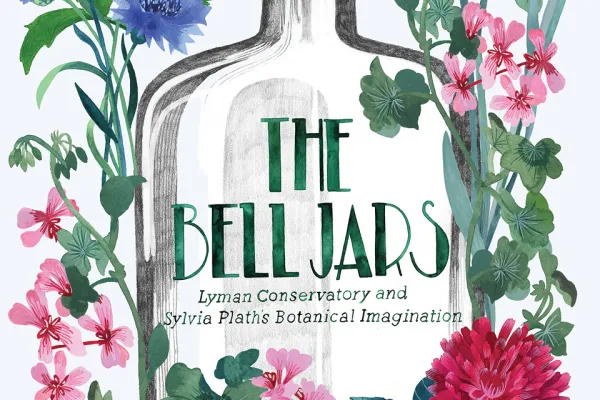Botanical Inspiration: New Views of Sylvia Plath
Research & Inquiry

Published September 11, 2023
What does the metaphor of the bell jar reveal about the life and work of Sylvia Plath ’55?
Associate Professor of Anthropology Colin Hoag and his students have been exploring that question in a research project that combines insights from anthropology, biological sciences, literature and women’s history.
Their findings are on display in an exhibit created in collaboration with the Botanic Garden of Smith College that opens September 15 in Lyman Plant House and Conservatory. The Bell Jars: Lyman Conservatory and Sylvia Plath’s Botanical Imagination uses archival materials and Plath’s writing to offer new views of her life and literary inspiration.
Visitors to the exhibit will see bell jars being used to help grow plants at Lyman. A listening station will feature recordings of Plath reading her poetry, and another display will include essays by students in Hoag’s anthropology seminar focusing on botanical themes in the famous alum’s writing.
Connecting to college history
The inspiration for Hoag’s project was personal. His grandmother, Barbara Brewster Hoag ’43, spoke often about her love for Smith. Professor Hoag’s own curiosity about college history led him to special collections at Neilson Library. At the same time, he began reading The Bell Jar, Plath’s 1963 novel about an artistic undergraduate struggling with societal constraints on women’s lives.
An “aha” moment occurred during a visit to the archives, when Hoag discovered that Plath had taken a botany course as a first-year student at Smith.
“I read her lab books and found that she was using a bell jar in her very first week of class,” he says. “I mentioned that to one of the horticulturists at Lyman Plant House and they said, ‘oh yes, we still have bell jars here’—probably the same ones Sylvia Plath used.”
By encouraging visitors to “inhabit Lyman as Plath once did,” the exhibit aims to highlight the role that plant science played in nurturing the author’s imagination. Karen Kukil—a Smith research affiliate and Plath scholar who was among the library and botanic garden staff members who helped with the project—notes that Plath routinely used bell jars in lab experiments, and some of the flowers she admired at Lyman, such as leopard orchids and camellias, appear in her later poems.
Reframing the metaphor
In contrast to the way the bell jar is used as a metaphor for oppression in Plath’s eponymous novel, Hoag says references from her early days as a Smith student are far more positive.
“In her journal, Sylvia Plath described life underneath a bell jar as demanding but rewarding—a site of contingent productivity,” he says. “She describes Smith College itself as a kind of bell jar. It’s an interesting example of a humanist being transformed by the science of botany.”
Sarah Loomis, manager of education for The Botanic Garden of Smith College, says Plath’s experience at Lyman is also part of a “narrative thread of the journey of women in the sciences” since botany was one of the few STEM disciplines open to women in her era.
“I hope visitors learn about the unique role that Lyman played in encouraging women to enter the botanical sciences at the same time they experience how the study of plants crosses many disciplines,” Loomis adds.
More Plath insights to come
Gabi Dondes ’26 and Emilia Neyer ’26—two students who helped create the exhibit at the plant house—are at work on a display centered on Plath’s experience as a student that will be on view in special collections in the spring.
“Having access to Plath’s own schoolwork, writing doodles and even grades helped me connect with her more,” says Dondes, who is majoring in neuroscience. “So much of Sylvia Plath’s legacy surrounds her death, where we should be celebrating the bright light that she left—much of which took place around Smith.”
Neyer points out that “while many people are familiar with The Bell Jar and some of Plath’s poetry, many still fail to recognize her as a young, impressionable student; someone they can relate to.”
“Gabi and I feel that Plath’s work can’t be fully grasped without an understanding of her time as a student and the influence that Smith and its environs had on her,” adds Neyer, who is majoring in biological sciences.
Plath’s connection to Lyman will also be a theme at the Fall Chrysanthemum Show in November, where Associate Professor Hoag will give the opening lecture.